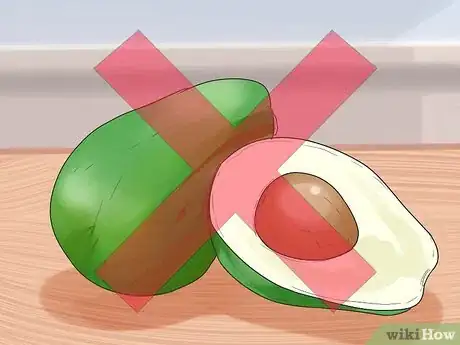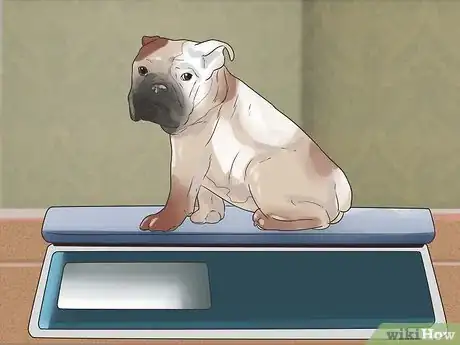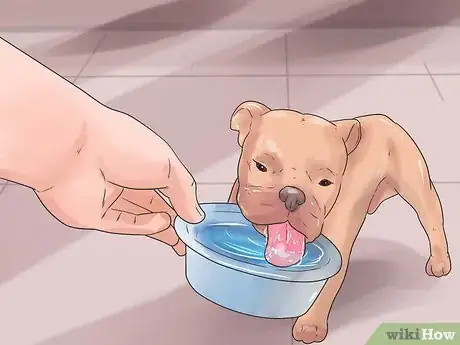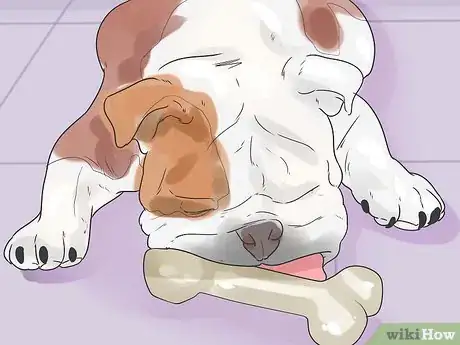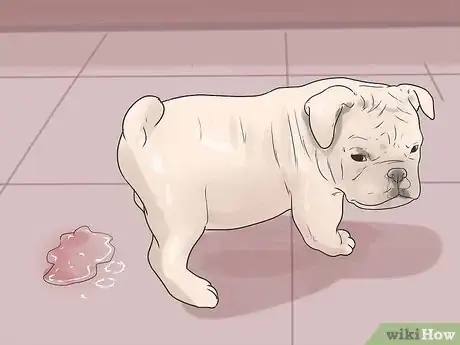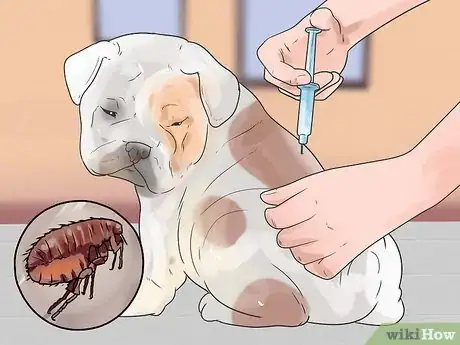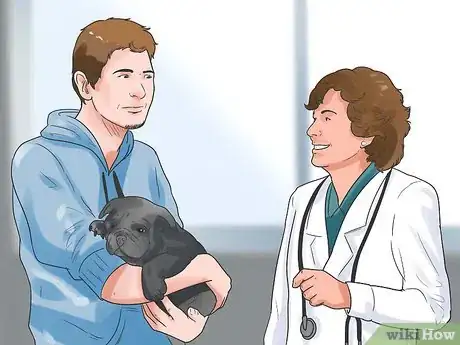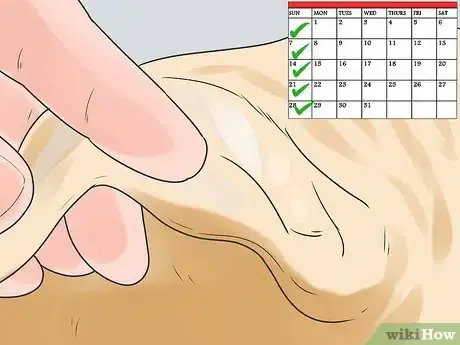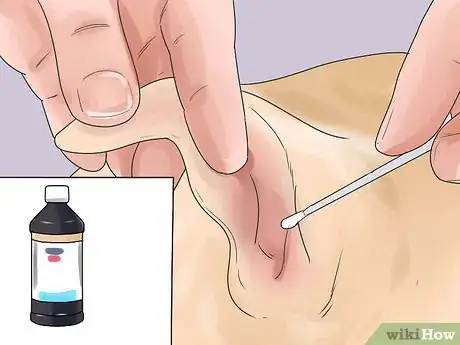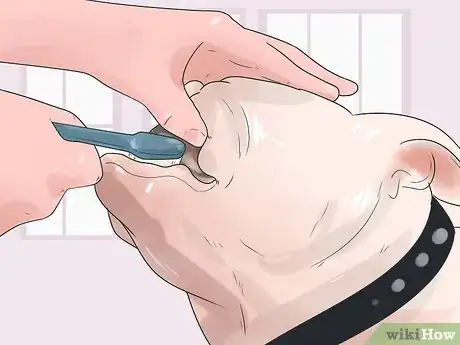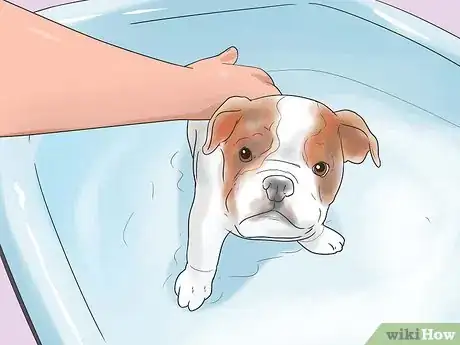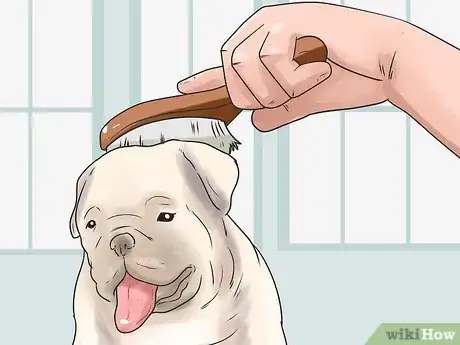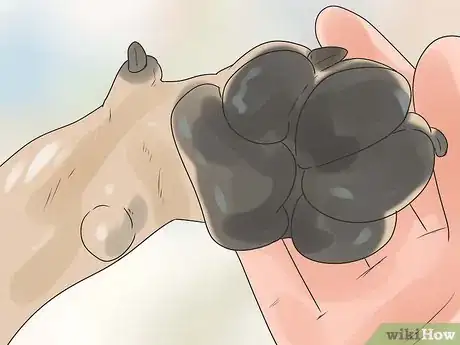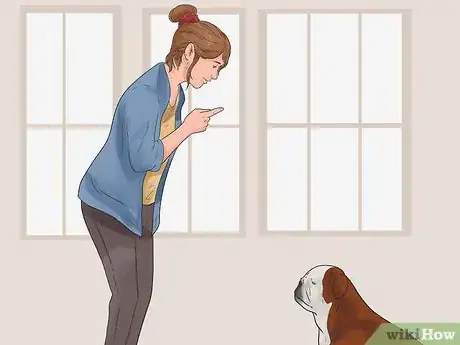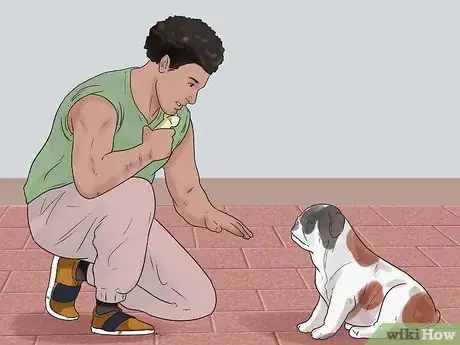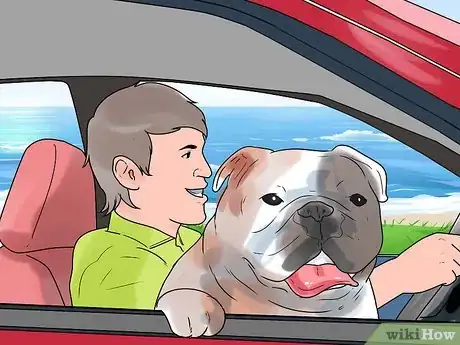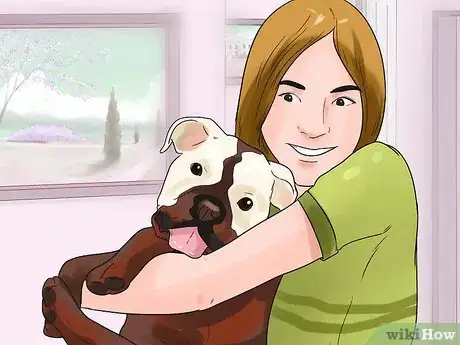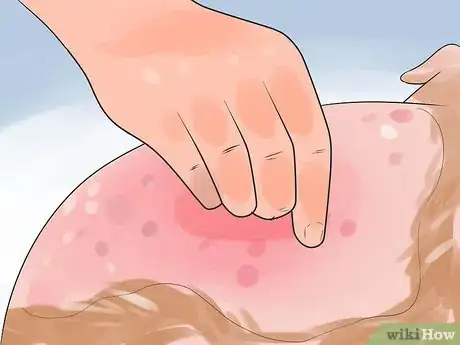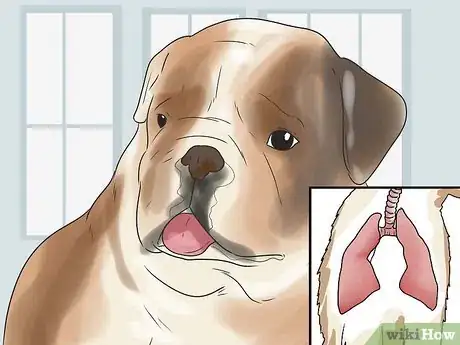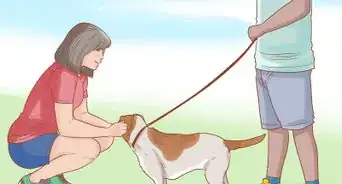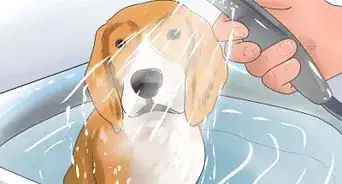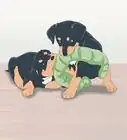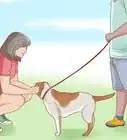This article was co-authored by Brian Bourquin, DVM. Brian Bourquin, better known as “Dr. B” to his clients, is a Veterinarian and the Owner of Boston Veterinary Clinic, a pet health care and veterinary clinic with three locations, South End/Bay Village, the Seaport, and Brookline, Massachusetts. Boston Veterinary Clinic specializes in primary veterinary care, including wellness and preventative care, sick and emergency care, soft-tissue surgery, dentistry. The clinic also provides specialty services in behavior, nutrition, and alternative pain management therapies using acupuncture, and therapeutic laser treatments. Boston Veterinary Clinic is an AAHA (American Animal Hospital Association) accredited hospital and Boston’s first Fear Free Certified Clinic. Brian has over 19 years of veterinary experience and earned his Doctor of Veterinary Medicine from Cornell University.
There are 9 references cited in this article, which can be found at the bottom of the page.
wikiHow marks an article as reader-approved once it receives enough positive feedback. This article received 13 testimonials and 92% of readers who voted found it helpful, earning it our reader-approved status.
This article has been viewed 369,318 times.
English Bulldogs are well known for their stocky builds, thick jowls, wrinkly skin, and “pushed in" faces. They are handsome and fun dogs that are great to have as a pet. English bulldog puppies require basic puppy care, however, because of some of their unique attributes, they also require a bit of special care. Just make sure to understand your puppy's special needs and it will be a loyal companion for years to come.
Steps
Feeding Your Puppy
-
1Change food brands gradually.[1] Buy a small supply of the food your dog has been fed before you brought it home. That way, your puppy's system won't go into shock due to a totally new food. If you want to change brands, do so slowly. Mix 1/2 and 1/2 for a week, then 1/4 and 3/4 for a week, then full change over.
-
2Feed your puppy on a regular schedule. You should feed it three times a day on a regular schedule for the first four months after arrival.[2] At 6 months you can start to cut back to 2 times a day and at 12 months you can cut it back further, to once a day.Advertisement
-
3Feed your English bulldog puppy a high-quality and well-balanced diet.[3] Usually readily available commercial food is fine for your puppy. Examine the first five ingredients on the dog food label; the first one or two ingredients should be meat (not meat by-products which are fine but they should be further down the list) followed by vegetables, and then grains.
- Once in a while an English bulldog will have signs of food intolerance (diarrhea, vomiting, or skin problems) to one or more of the ingredients in a food. If your puppy or dog shows these signs, you will need to work with your veterinarian to determine the cause and then follow a strict lifelong diet to minimize symptoms.
-
4Avoid feeding your dog people food, especially foods that are dangerous to its system. Keep in mind that there are certain human foods that can make a dog sick or outright kill it.[4] Foods that at toxic to dogs include (but are not limited to):
- Avocados
- Alcohol
- Chocolate
- Grapes and raisins
- Chives, onions, and garlic
- Nuts
- Yeast doughs
- Anything made with the sweetener xylitol especially found in sugar-free gums
-
5Watch your dog's weight. English bulldogs can put on weight easily, so you need to watch that your puppy doesn’t get overweight. If your puppy is putting on too much weight, consult with your veterinarian about the best, and safest, way to keep your dog's weight in balance.
- Remember treats add calories to the diet so they should be fed in tiny amounts and sparingly. Reserve these for when your puppy is training.[5]
- Monitor your bulldog’s body condition score (BCS) to determine if it is overweight (or underweight) on a monthly basis. A normal-weight dog will have a “tucked” abdomen (when viewed from the side) and its ribs will be easily felt but not seen. A fat dog will lose the abdomen tuck, as fat accumulates here and on the ribs cage. An underweight dog will have a more extreme abdomen tuck and its ribs will both be easily felt and easily seen.
-
6Provide clean fresh water at all times. This is especially important in hot or humid weather but should be provided all of the time. Also remember to wash out food and water bowls with soap and water a couple of times a week, as bulldogs can be quite slobbery.
Caring For the Health of Your Puppy
-
1Watch for teething when the puppy arrives home. Please be sure to provide many chew toys to help with this transitional period. Cow hooves can be found at many pet stores and are recommended. Stay away from pig ears and cheap rawhide, and "greenies," as these can cause severe diarrhea, bloat, and are a choking hazard.
-
2Monitor your puppy's health. For instance, keep an eye out for diarrhea if you change your pup's food. If your bulldog develops diarrhea then stop all food for 12 hours. If it persists for more than 24 hours, contact your veterinarian immediately to prevent dehydration. Puppies can dehydrate very rapidly so you need to take it seriously when diarrhea occurs.
-
3Get your puppy preventative treatment for local pests. Dogs can pick up some unwanted guests: ticks, fleas, mites, lice, and intestinal worms. Your dog can be the perfect host for these pests if regular treatment for these nasty pests is not given. Your veterinarian is the best source of knowledge for the local bugs that bug the local dog population and how to prevent these pests.
- Heartworm is a widespread disease present spread by mosquitoes throughout most of the United States.[6] A yearly blood test is taken to make sure the dog isn’t infected with this nasty parasite, then a monthly tablet or a shot that lasts for up to 6 months is used to kill any organisms present in the bloodstream. There is a treatment for heartworm, but it is expensive and takes a toll physically on the dog and can take months to combat.
- Another vaccination to consider, especially if you live in an endemic area, is the Lyme’s disease vaccination. This is especially important for dogs that spend a lot of time outside, that live on farms, or that hunt, as they are at increased risk of contracting this tick-borne disease. In addition to joint pain, swelling, and fevers, dogs can also get a generally fatal kidney disease as the consequence of contracting Lyme’s disease.
-
4Take your puppy for regular veterinary checkups. Puppies will generally have a first veterinary visit at the age of six weeks by the person who has the mother dog. The veterinarian will examine the puppies to make sure there are no hernias, heart, lung, or eye or ear problems in any of the pups. Generally, they will be de-wormed at this time and be given their first puppy shot (the distemper” vaccine). At 9 weeks, and then again at 12 weeks, the de-wormer and distemper vaccines will be repeated. Then these can be given once a year or on a schedule determined by you and your veterinarian.[7]
- At the 12 weeks visit the rabies vaccination will be given—although this may vary depending on local laws. This vaccination is required by many communities. There can sometimes be severe penalties if your dog is not rabies vaccinated especially if the dog bites a person or another pet.
- As your dog ages, more frequent examinations will need to be given. Twice yearly examination will catch medical issues before they become big problems. Older dogs frequently suffer from arthritis and heart disease just like elderly humans. There are effective and safe treatments that can help your older dog live reasonably pain-free and pleasant golden years.
-
5Desex your puppy at an appropriate age. It is important to spay (females) or neuter (male) your puppy.[8] In addition to various health benefits for the dog (decreased chances of certain tumors and infections), there is a big societal benefit in the decreased number of unwanted dogs. Microchipping is also encouraged in case your dog ever becomes lost.
-
6Examine English bulldog’s ears once a week. The inner ear part of the ear is normally white or darker colored, usually corresponding to the color of the dog's coat, so look for discoloring. The puppy's ears should also not smell nor have any discharge in the ear or on the flap. The ear should be free of debris, dirt, or parasites, like ticks or mites. Any of the following are abnormal:[9]
- Scratching or pawing the ear.
- Shaking the head excessively.
- Waxy fluid or brown discharge from the ear.
-
7Clean your puppy's ears regularly. You can clean the ears using a product specifically made to clean a dog’s ears.[10] Saturate a cotton ball with the fluid and gently wipe it in the dog’s ear. If in doubt, or if you suspect an ear infection, have your veterinarian look in the ear using an otoscope to examine the eardrum.
- Never stick a q-tip or similar type of product into the ear canal. A dog’s ear canal takes a sharp turn when it meets the head. You will not be able to see the entire ear canal and should not try to put anything down there.
-
8Brush your English bulldog puppy’s teeth daily.[11] By brushing daily (or at least 2 to 3 times a week), you will remove the bacteria and plaque that build up each day on the teeth. It also gives you a great opportunity to examine your dog’s mouth for loose or damaged teeth, sores, growths, or any unusual things, and bring them to your veterinarian’s attention at an early stage before they become big problems.
- Never use human toothpaste on a dog; only use dental toothpaste made for dogs. The fluoride in human toothpaste is poisonous to dogs and can cause serious health problems.
- Place a little puppy toothpaste on your fingertip and let your puppy lick it off. The next day put it on your finger and rub it along the outer gums. Then try to put a little on a dog toothbrush, let the puppy lick it then run the toothbrush along the outer edges of the teeth and gums. Only the outer part (against the cheeks) needs to be brushed. It should only take about 30 seconds to brush the puppy’s teeth.
- Even with regular tooth brushing, dogs may need dental cleanings once in a while. Plaque and bacteria can build up under the gum line causing problems there or in the roots of the teeth. Just like with their human owners, regular mouth examinations by their doggy dentist should be done once a year.
Grooming Your Puppy
-
1Clean your puppy regularly. Because of the English bulldog's skin folds, especially those on the face and around the lips, will need to be carefully examined each day for signs of infection. Normal yeast found on the body will thrive and flourish in these dark, warm, and moist crevices. These should be gently washed and thoroughly dried at least every other day, more often in those dogs prone to infections.
-
2Brush your puppy regularly. The English bulldog’s short hair coat will shed so a thorough brushing once a week with a soft-bristled brush is recommended. While you’re grooming, keep an eye open for any fleas, ticks, or mites, along with any lumps, bumps, or cysts on the skin. These, along with any scabs, redness, or itchy skin, should be brought to your veterinarian’s attention.
-
3Inspect your puppy's feet regularly. Brushing time is a good time to look at the nails and paws. The nails might need to be clipped. If you haven’t performed this before, ask your veterinarian technician to demonstrate. The procedure needs to be done correctly so you don’t trim the “quick,” or the part of the nail where the blood vessels and nerves are.
- Once a dog has been “quicked,” or the quick has been cut, it will be hard to trim your puppy's nails, due to fear of pain and bleeding.
Training Your Puppy
-
1Give your new puppy direct instruction. Puppies will naturally follow a pack leader and you need to be that leader.[12] As its leader, you need to teach the puppy how to behave and fit into their new environment. They are not baby geniuses, nor are they mind readers. They need patience and repetition with much positive reinforcement. If you cannot handle a problem that you are encountering, contact a local professional canine behavior specialist.
-
2Train your puppy to follow your commands. You will want to teach the puppy to sit, stay, and come on command. In addition, it is also important to begin house training your puppy early on.[13] All of this training is most successful when you use positive reinforcement with your puppy. Instead of punishing your puppy when it doesn't do the right thing, you need to make it a pleasurable experience when it does the right thing. Give your dog a treat (either a snack or praise and love) when it follows your directions and it will make the puppy want to do what you say!
- Teaching your puppy to heel while walking on a leash is also important. Not only is it a good way for your puppy to learn direction, it also gives them exercise and socialization out in the world. Just be sure not to walk your puppy too much. Little puppies get pooped out really easily, so don't walk them into the ground.
-
3Begin socializing your puppy early. Socialization is very important to make sure your puppy gets along well with other dogs, other animals, and humans. Younger puppies under the age of 14 to 16 weeks are most amenable to socialization, as after this age they become more wary of new situations, humans, and other animals.
- Get your puppy used to riding in the car and walking around the neighborhood. You should also get it used to humans of all ages, sizes, colors, and genders (safely and in a friendly way). Also, make sure to safely introduce him to friendly dogs and cats.
- A great way to introduce the puppy to people and dogs is at puppy socialization or obedience classes held at large pet stores, veterinary clinics, or through community courses.
-
4Give your puppy lots of attention and love. You need to create a bond of love and trust between you and your new puppy. While it's important for the puppy to follow your commands, it's also important for the puppy to feel that you love and care for it. Spend quality time with your new puppy every day, making sure that most of it is playing and cuddling, and not all structured training.
Caring For the Special Needs of an English Bulldog Puppy
-
1Keep your English bulldog puppy in moderate temperatures. These puppies are temperature sensitive. They can suffer from heatstroke very easily but are also sensitive to the cold.
- Be sure to keep your puppy cool enough in summer months. Any temperature of 90 degrees or above can be very dangerous. If you take your puppy out during a hot day, be sure to wet it down and provide unlimited water to drink.
- Keep the puppy's time out to a minimum during extreme heat.
- Bulldog puppies can get cold very easily. Be sure to keep it in a warm environment during colder months to avoid catching a cold. During winter months, it may be necessary to keep the puppy warm by using a sweater or sweatshirt and doggie booties while outside. It should not be kept in temperatures of 60 degrees or less for extended periods of time.
-
2Watch your puppy's coat for signs of allergies. As with other popular breeds, bulldogs are genetically predisposed to Atopic Dermatitis, which is a skin condition that results in irritation on the skin.[14] Research indicates that of the 30% of canines who do suffer from allergies, 85% suffer from allergies to pollens, mites & mold spores. Consult with your veterinarian about solutions if your puppy's skin becomes red and irritated.
-
3Monitor your puppy's breathing. Because of their short muzzle (nose), bulldogs are prone to respiratory and breathing difficulties. Hot weather, humid weather, too much strenuous exercise, and any illness affecting the nose, throat, or lung will make it hard for your bulldog to get enough air into its body. Bring your puppy into an air conditioned room during hot or humid weather and only exercise it inside during extremes of weather.
- If your bulldog starts to pant it is time to end the exercise and give it a breather.
Expert Q&A
Did you know you can get expert answers for this article?
Unlock expert answers by supporting wikiHow
-
QuestionHow many times a day should I feed my English Bulldog puppy?
 Brian Bourquin, DVMBrian Bourquin, better known as “Dr. B” to his clients, is a Veterinarian and the Owner of Boston Veterinary Clinic, a pet health care and veterinary clinic with three locations, South End/Bay Village, the Seaport, and Brookline, Massachusetts. Boston Veterinary Clinic specializes in primary veterinary care, including wellness and preventative care, sick and emergency care, soft-tissue surgery, dentistry. The clinic also provides specialty services in behavior, nutrition, and alternative pain management therapies using acupuncture, and therapeutic laser treatments. Boston Veterinary Clinic is an AAHA (American Animal Hospital Association) accredited hospital and Boston’s first Fear Free Certified Clinic. Brian has over 19 years of veterinary experience and earned his Doctor of Veterinary Medicine from Cornell University.
Brian Bourquin, DVMBrian Bourquin, better known as “Dr. B” to his clients, is a Veterinarian and the Owner of Boston Veterinary Clinic, a pet health care and veterinary clinic with three locations, South End/Bay Village, the Seaport, and Brookline, Massachusetts. Boston Veterinary Clinic specializes in primary veterinary care, including wellness and preventative care, sick and emergency care, soft-tissue surgery, dentistry. The clinic also provides specialty services in behavior, nutrition, and alternative pain management therapies using acupuncture, and therapeutic laser treatments. Boston Veterinary Clinic is an AAHA (American Animal Hospital Association) accredited hospital and Boston’s first Fear Free Certified Clinic. Brian has over 19 years of veterinary experience and earned his Doctor of Veterinary Medicine from Cornell University.
Veterinarian
-
QuestionIs it best to own a male or female English Bulldog?
 Pippa Elliott, MRCVSDr. Elliott, BVMS, MRCVS is a veterinarian with over 30 years of experience in veterinary surgery and companion animal practice. She graduated from the University of Glasgow in 1987 with a degree in veterinary medicine and surgery. She has worked at the same animal clinic in her hometown for over 20 years.
Pippa Elliott, MRCVSDr. Elliott, BVMS, MRCVS is a veterinarian with over 30 years of experience in veterinary surgery and companion animal practice. She graduated from the University of Glasgow in 1987 with a degree in veterinary medicine and surgery. She has worked at the same animal clinic in her hometown for over 20 years.
Veterinarian This is largely a matter of personal preference. As a rule, male dogs are slightly larger, so if space is an issue, then a female might be better. Likewise, it is important to neuter a female dog to prevent unwanted pregnancy or pyometra in later life - this surgery is expensive, so you may wish to take this into consideration. More important than gender is finding a well-socialized puppy and keeping up with its socialization so it grows into a well-adjusted adult.
This is largely a matter of personal preference. As a rule, male dogs are slightly larger, so if space is an issue, then a female might be better. Likewise, it is important to neuter a female dog to prevent unwanted pregnancy or pyometra in later life - this surgery is expensive, so you may wish to take this into consideration. More important than gender is finding a well-socialized puppy and keeping up with its socialization so it grows into a well-adjusted adult. -
QuestionAre Bulldogs hard to train?
 Pippa Elliott, MRCVSDr. Elliott, BVMS, MRCVS is a veterinarian with over 30 years of experience in veterinary surgery and companion animal practice. She graduated from the University of Glasgow in 1987 with a degree in veterinary medicine and surgery. She has worked at the same animal clinic in her hometown for over 20 years.
Pippa Elliott, MRCVSDr. Elliott, BVMS, MRCVS is a veterinarian with over 30 years of experience in veterinary surgery and companion animal practice. She graduated from the University of Glasgow in 1987 with a degree in veterinary medicine and surgery. She has worked at the same animal clinic in her hometown for over 20 years.
Veterinarian
Warnings
- Bulldogs can’t really swim and can drown in water deeper than their legs. Keep them away or else put a dog life jacket on your bulldog and keep a very close eye on the dog.⧼thumbs_response⧽
- Avoid: Excessive heat, Excessive cold, Soft latex, or breakable toys - these can be a choking hazard⧼thumbs_response⧽
References
- ↑ Brian Bourquin, DVM. Veterinarian. Expert Interview. 20 December 2019.
- ↑ Brian Bourquin, DVM. Veterinarian. Expert Interview. 20 December 2019.
- ↑ Brian Bourquin, DVM. Veterinarian. Expert Interview. 20 December 2019.
- ↑ http://www.aspca.org/pet-care/virtual-pet-behaviorist/dog-behavior/foods-are-hazardous-dogs
- ↑ Brian Bourquin, DVM. Veterinarian. Expert Interview. 20 December 2019.
- ↑ https://www.heartwormsociety.org/pet-owner-resources/heartworm-basics
- ↑ Blackwell's Five-Minute Veterinary Practice Management Consult. Lowell Ackerman. John Wiley & Sons. 2006
- ↑ Brian Bourquin, DVM. Veterinarian. Expert Interview. 20 December 2019.
- ↑ https://www.aspca.org/pet-care/dog-care/ear-care
- ↑ https://www.aspca.org/pet-care/dog-care/ear-care
- ↑ https://www.aspca.org/pet-care/dog-care/ten-steps-your-dogs-dental-health
- ↑ https://www.cesarsway.com/dog-training/puppy/starting-your-puppy-off-right
- ↑ https://www.aspca.org/pet-care/virtual-pet-behaviorist/dog-behavior/house-training-your-puppy
- ↑ http://www.petmd.com/dog/conditions/skin/c_dg_atopic_dermatitis
About This Article
To take care of an English bulldog puppy, feed it a high-quality commercial dog food 3 times a day. Additionally, brush your puppy’s teeth daily using toothpaste made specifically for dogs. You should also clean your pet’s face at least every other day and brush its coat once a week to keep it well groomed. When you walk or play with your puppy, make sure to take a break if you hear it panting, since bulldogs are prone to respiratory and breathing problems. For more tips from our Veterinary co-author, including how to train and socialize your new puppy, keep reading!




